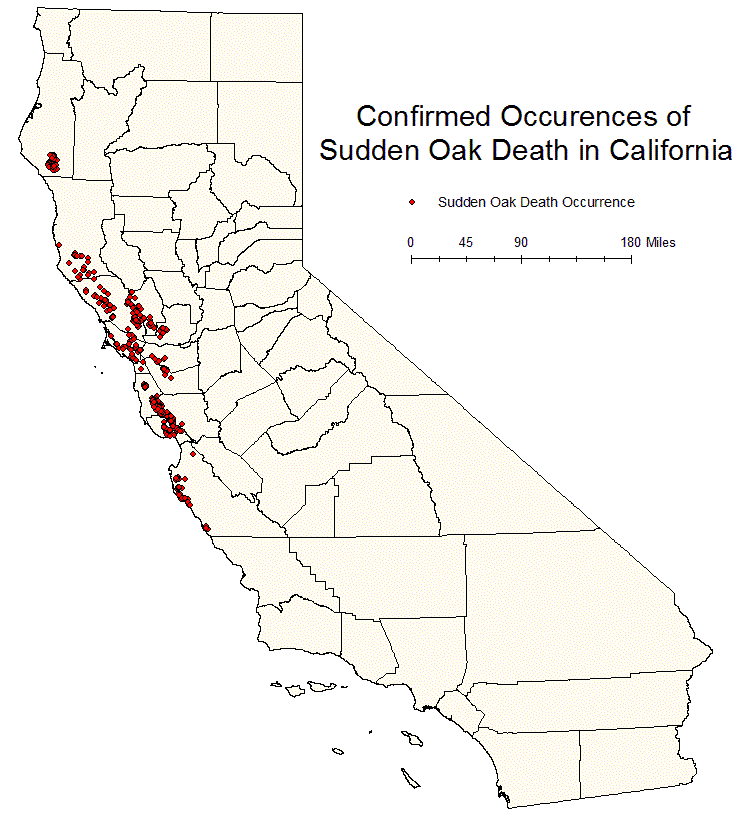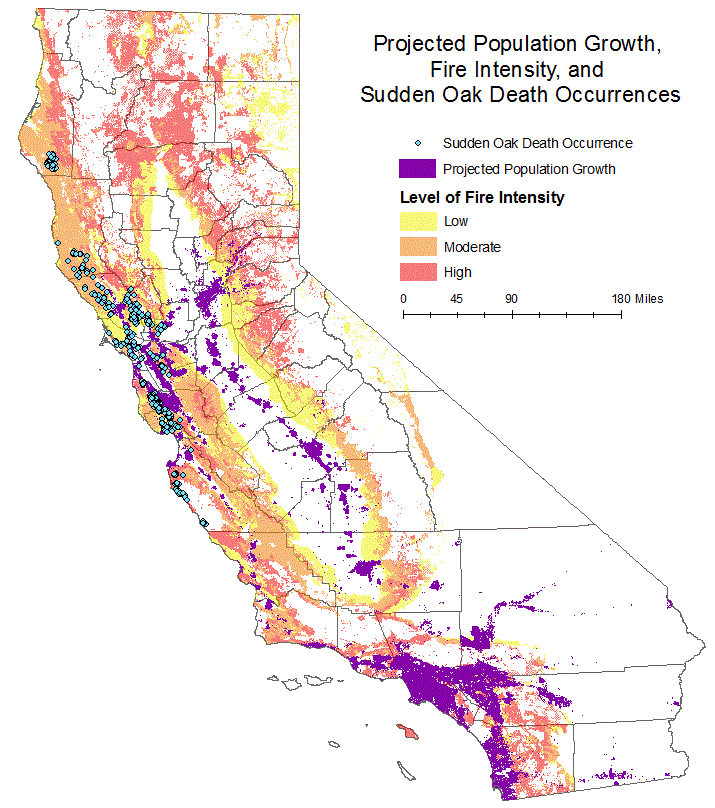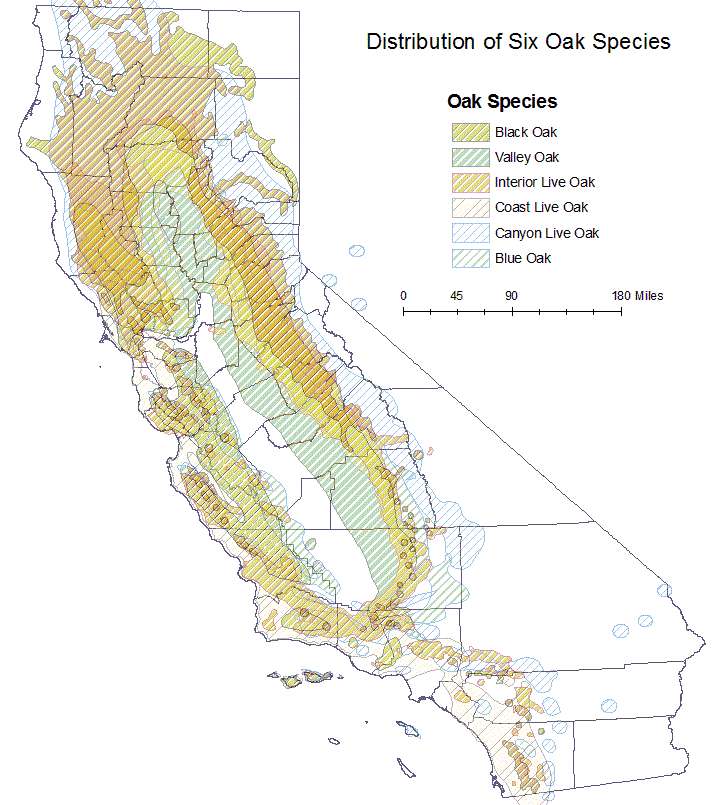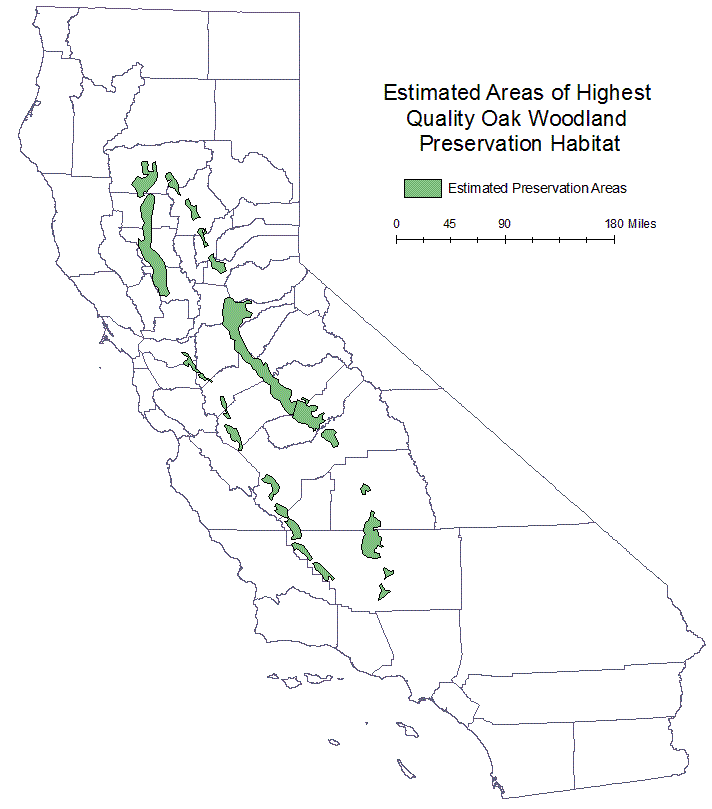| Preserving California's Oak Trees:
An Evaluation of Factors Impacting Oak Woodlands | |
|
Written By:
American River College, Sacramento, California Geography 350: Data Acquisition in GIS; Spring 2010 Contact Information: jmherrig@hotmail.com | |
|
Abstract
The foothills that surround California’s Central Valley are home to a unique ecosystem: oak woodland. Oak woodland ecosystems are defined as a transitional vegetation community between open grassland and deciduous forests where the dominant tree is oak. Within California, these trees have been dramatically declining in numbers and regeneration of new oak trees is minimal. The main factors that have been contributing to the decline in oak trees around the Central Valley are urban growth, sudden oak death, and altered fire regimes. Urban growth has severally reduced the natural extent of oak habitat. Sudden oak death occurrences are increasing, and stopping or reducing the spread is of sudden oak death is very difficult. The natural fire regime within oak woodlands has been altered dramatically which has allowed some areas of oak woodlands to be unaffected by fire for ten or more years. This paper will examine all three of these factors using GIS to create an analysis of where oaks have been affected the most by these factors and where oaks have the greatest chance of continuing. | |
|
Introduction The distribution of oak woodlands within California has been decreasing steadily over the last several decades due to several factors. This report will evaluate these negative factors all together in order to approximate the location of oak woodlands that should have the best chance of being preserved before negative factors affect them enough to cause a decline in oak populations. | |
|
Background | |
| The first negative factor, dramatic increases in human population, has created a noticeable direct impact towards oaks. This can be seen in the conversion of oak habitat into housing/commercial developments and livestock rangelands. Between 1945 and 1973, an estimated 1.2 million acres of oak woodlands were converted to other land uses, and by 1986, loss of oak woodlands increased to about 14,000 acres per year (Gorton 1997). Projected population growth for California in 2025 is estimated between 44 million to 48 million from 37 million in 2005 with the fastest growth occurring in inland areas rather than coastal (CA2025). Human population growth reduces and fragments oak woodlands allowing further stress to ensue within the ecosystem. |

California's Projected Growth to 2050 |
| Another factor that plays a role in the health of oak woodlands is fire. California has a Mediterranean climate which is cold and wet in the winter and hot and dry in the summer. This type of climate, historical, creates a low-intensity fire regime which many oak trees can tolerate. Oak trees within woodlands had adapted to frequent, low-intensity fires which help promote healthy acorns and growth (Carle 2008). Fires are important because they reduce the amount of non-native plants and pathogens within the ecosystem. Fire can also promote regeneration in some oaks by causing rapid basal sprouting (Holmes, et al. 2008). When the gold rush occurred in 1848, fire frequency increased and then drastically decreased in the 1940s when the federal and state governments decided that preventing wildfires would increase lumber production (Holmes, et al. 2008). When fire is excluded from oak woodlands, competition from other tree species like conifers reduce the overall health of oaks by increasing fuel loads to allow a high-intensity fire to occur which will kill the oak trees (Carle 2008). |

Fire Risk in California |
| Sudden oak death is caused by a pathogen named Phytophthora ramorum. This pathogen is called sudden oak death because large groups of infected oaks appear to die rapidly (Rizzo and Gardbelotto 2003). Sudden oak death is a non-native pathogen that, within the last ten years, has greatly affected oaks. Several of the understory species within oak woodlands can act as the host of the pathogen without being affected which allows it to spread (Kelly and Meentemeyer 2002). However, studies have shown that oak trees that are considered red oak or intermediate oaks are the only infected oaks within the field (Rizzo and Gardbelotto 2003). Blue oaks and valley oaks appear to be unaffected by sudden oak death because they are considered white oak. Occurrences of sudden oak death are concentrated within California’s coastal counties where red oaks and intermediate oak are found. Finally, sudden oak death can alter wildfire intensity by increasing the fuel load in short periods of time, but wildfire can reduce the chance of sudden death occurrences by reducing the amount of host species (Lee 2009). |

Confirmed Sudden Oak Death Occurrences in California |
|
Methods The information for this topic was relatively easy to find. About half of the data was properly georeferenced. However, the other half of the data was not and it had to be spatially adjusted within ArcMap. In searching for data, I was unable to find a document that outlined oak woodland habitat distribution within California. I did find individual species distributions. I choose six oak species that occur within oak woodlands and used the combined distribution to estimate where oak woodlands could occur. Once I had all the data that was required, I combine them together to see how all the areas overlapped. I then created a new shape file and created polygons of the estimated areas within oak woodlands that would have the highest quality for preservation. A polygon was created in an area that had a low fire-intensity, little to no population growth, and no occurrences of sudden oak death. | |
|
Results Once all the information was combined, I was
able to analyze the information and determine which areas of oak woodlands would have the
highest quality of preservation based on the three factors. The data showed that there
are several areas of oak woodlands that would have a high chance of being preserved in
order to allow for the regeneration and growth of oaks. | |
|
Figures and Maps | |

All three factors combined together. |

Distribution of six oak species that are foudn within oak woodlands. |

Estimated Areas of High Quality Preservation Areas. |
As it can be see on the map to the left, there are several areas of potential oak woodland habitat areas. |
|
Analysis The results were very successful. Once the
data was all collected and spatially adjusted, it was relatively easy to see the results.
The difficulties during this report were trying to find data that was already georeferenced
rather than trying to spatially adjust the information. It took several attempts and
adjusting before the oak distributions appeared to be in the proper location. Furthermore,
the data on sudden oak death was readily available expect it was only offered in Google
Earth .kml format which is not compatible with ArcMap. I was able to acquire a .shp format
version of the data once I was able to contact the author of the data. | |
|
Conclusions The results were very successful, however
I thought the amount of high quality oak woodland would be much less. Further research
showed that another major factor that reduces oak woodland habitat is livestock grazing.
Livestock grazing is very extensive in California. The livestock will graze on oak
seedling and sapling preventing them from growing. The next step to further this report
would be to include livestock graze lands. I think by doing so will greatly decrease the
amount of potential oak woodland preservations. | |
|
References California 2025. September 2008. California’s Future Population: Just the Facts. Public Policy Institute of California, http://www.ppic.org/content/pubs/jtf/JTF_FuturePopulationJTF.pdf. Carle, D. Introduction to Fire in California. University of California Press: Berkeley, CA: 2008. Fire and Resource Asssement Proram (FRAP). 2007. California Department of Forestry and Fire Protection, http://frap.cdf.ca.gov/data/frapgisdata/select.asp. Gorton, T. B. 1997. Resolving Oak Woodland Issues in California. USDA Forest Service General Technical Report PSW-GTR-160. Holmes, K.A., Veblen, K.E., Young, T.P., and Berry, A.M. October 2006. California Oak and Fire: A Review and Case Study. USDA Forest Service General Technical Report PWS-GTR-217. Kelly, M. and Meentemeyer, R. K. October 2002. Landscape Dynamics of the Spread of Sudden Oak Death. Photogrammetric Engineering & Remote Sensing, 64 (10): 1001-1009. Kelly, N.M. and Tuxen, K. September 2003. WebGIS for monitoring "Sudden Oak Death" in coastal California. Computers, Environment and Urban Systems, 27 (5): 527-5474. Lee, C. 2009. Sudden oak death and fire in California. California Oak Mortality Task Force, http://www.suddenoakdeath.org/pdf/summary%20of%20fire%20and%20p%20ramorum%20issues%20v5.3. pdf. Plant Maps. 2010. http://www.plantmaps.com/index.php. Rizzo, D.M. and Garbelotto, M. 2003. Sudden oak death: endangering California and Oregon forest ecosystems. Frontiers in Ecology and the Environment, 1 (5): 197-204. | |